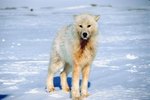
Despite differences between species, wolves defend themselves in the same ways. With their strong jaws, pack mentality and pragmatic hunting strategies, these animals are able not only to hold their own against attackers, but effectively prey upon beasts significantly larger than they are. Because they are so skilled at self-defense, the wolf's greatest natural enemy (besides humans) are other wolves.
Strength in Numbers
Wolves live in packs with distinct social hierarchies, and these packs do everything together. Comprising 6 to 10 wolves, the pack lives, sleeps, travels and hunts together, working as a unit that is significantly more efficient than any wolf on his own. Wolves fiercely protect each other within the pack, and their teamwork enables them to safely kill much larger animals with defense mechanisms of their own, like moose with massive antlers and powerful legs.
Vicious Bites
A wolf's most powerful weapon is his mouth, equipped with large teeth and strong jaws. He uses his jaws to snap, bite and tear at foes, clamping down with enough force to crunch through bones. To put the power of his bite into perspective, he can apply as much as 1,500 pounds of pressure per square inch -- twice the strength of a German shepherd. Just a few bites from these powerful jaws can incapacitate an enemy, leaving it vulnerable enough for the wolf to finish it off.
Selective Predation
Though they frequently kill large prey like moose, deer, bison and goats, wolves are pragmatists, and their selective nature is a powerful defense mechanism. Wolves actively choose to pursue prey that is either very young or very old, and therefore less effective at fighting back -- a full-sized bison in the prime of its life, for example, is a much more dangerous target than a calf. Because wolves consciously pursue less able-bodied prey, they give themselves a distinct advantage before the fight even starts.
Adaptability
The ability to adapt is critical for self-preservation and defense of the pack, so wolves exhibit a tendency to move around. While a wolf pack typically stays within a certain territory, that territory can be as large as 1,000 square miles, and the pack may travel as much as 50 miles a day looking for food. This is largely because of their bodies, which are uniquely adapted for frequent, extensive ground travel -- adaptations like long legs and excellent balance equip them to defend the pack by seaching far and wide for food.
References
Photo Credits
-
Tom Brakefield/Stockbyte/Getty Images
Writer Bio
Tom Ryan is a freelance writer, editor and English tutor. He graduated from the University of Pittsburgh with a degree in English writing, and has also worked as an arts and entertainment reporter with "The Pitt News" and a public relations and advertising copywriter with the Carnegie Library of Pittsburgh.




